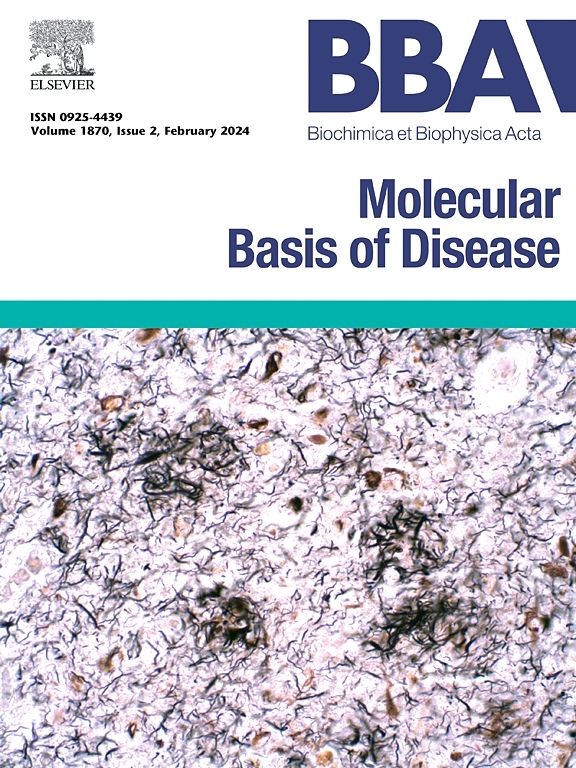Hydroxysafflor yellow A inhibits neuronal ferroptosis and ferritinophagy in ischemic stroke
IF 4.2
2区 生物学
Q2 BIOCHEMISTRY & MOLECULAR BIOLOGY
Biochimica et biophysica acta. Molecular basis of disease
Pub Date : 2025-04-23
DOI:10.1016/j.bbadis.2025.167867
引用次数: 0
Abstract
Ischemic stroke is a significant cause of disability and mortality on a global scale, with neuronal dysfunction playing a critical role in its pathogenesis. Conventional treatment approaches for ischemic stroke involve surgical interventions and thrombolytic therapy, yet these methods frequently result in ischemia/reperfusion (I/R) injury. Recent studies have underscored the implication of diverse programmed cell death mechanisms, including ferroptosis, in the progression of ischemic stroke. Ferroptosis, a newly recognized form of cell death reliant on iron, is intricately linked to various neurological conditions. Despite the existing body of research on ferritinophagy and neuronal ferroptosis in the context of cerebral ischemia-reperfusion injury, there is a lack of understanding regarding the mechanisms involved in neuronal ferroptosis. This study seeks to explore the relationship between neuronal autophagy and neuronal ferroptosis using in vivo and in vitro models of cerebral ischemia/reperfusion. The findings of our study reveal a significant upregulation of the ferritinophagy-associated protein NCOA4 following cerebral ischemia/reperfusion, concomitant with the initiation of ferroptosis in neuronal cells. This observation offers compelling support for a direct association between neuronal ferritinophagy and ferroptosis. Hydroxysafflor Yellow A (HSYA), a traditional Chinese herb, shows promise in reducing brain ischemia/reperfusion injury, but its exact protective mechanism is still unknown. Our study reveals a new way HSYA protects the brain by preventing neuronal ferroptosis after a stroke, a mechanism not previously reported.

羟基红花黄A抑制缺血性脑卒中神经元铁蛋白凋亡和铁蛋白吞噬
缺血性脑卒中是全球范围内致残和死亡的重要原因,神经元功能障碍在其发病机制中起着关键作用。缺血性脑卒中的传统治疗方法包括手术干预和溶栓治疗,但这些方法经常导致缺血/再灌注(I/R)损伤。最近的研究强调了多种程序性细胞死亡机制的含义,包括铁下垂,在缺血性卒中的进展。铁下垂是一种新发现的依赖铁的细胞死亡形式,与各种神经系统疾病有着复杂的联系。尽管已有大量关于脑缺血-再灌注损伤背景下铁蛋白吞噬和神经元铁下垂的研究,但对神经元铁下垂的机制尚缺乏了解。本研究旨在通过脑缺血/再灌注的体内和体外模型探讨神经元自噬与神经元铁凋亡之间的关系。我们的研究结果揭示了脑缺血/再灌注后,铁蛋白噬噬相关蛋白NCOA4的显著上调,并伴随着神经元细胞铁凋亡的开始。这一观察结果为神经元自噬铁蛋白和铁下垂之间的直接联系提供了强有力的支持。羟基红花黄A (Hydroxysafflor Yellow A, HSYA)是一种具有减轻脑缺血再灌注损伤作用的中药,但其确切的保护机制尚不清楚。我们的研究揭示了HSYA通过预防中风后神经元铁下垂来保护大脑的一种新方式,这一机制以前没有报道过。
本文章由计算机程序翻译,如有差异,请以英文原文为准。
求助全文
约1分钟内获得全文
求助全文
来源期刊
CiteScore
12.30
自引率
0.00%
发文量
218
审稿时长
32 days
期刊介绍:
BBA Molecular Basis of Disease addresses the biochemistry and molecular genetics of disease processes and models of human disease. This journal covers aspects of aging, cancer, metabolic-, neurological-, and immunological-based disease. Manuscripts focused on using animal models to elucidate biochemical and mechanistic insight in each of these conditions, are particularly encouraged. Manuscripts should emphasize the underlying mechanisms of disease pathways and provide novel contributions to the understanding and/or treatment of these disorders. Highly descriptive and method development submissions may be declined without full review. The submission of uninvited reviews to BBA - Molecular Basis of Disease is strongly discouraged, and any such uninvited review should be accompanied by a coverletter outlining the compelling reasons why the review should be considered.

 求助内容:
求助内容: 应助结果提醒方式:
应助结果提醒方式:


